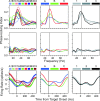Behavioral context and coherent oscillations in the supplementary motor area
- PMID: 15128859
- PMCID: PMC6729448
- DOI: 10.1523/JNEUROSCI.0047-04.2004
Behavioral context and coherent oscillations in the supplementary motor area
Abstract
Movements with similar physical characteristics can occur in various behavioral contexts, as when they are embedded in different sequences or when the expected outcomes of movements vary. Similarly, neurons in various sensory and motor structures in the brain commonly display modulations in their activity according to contextual factors, such as expected reward. Although these contextual signals must be combined with incoming sensory inputs to generate appropriate behaviors according to the animal's motivational state, the mechanisms by which these two signals are integrated remain poorly understood. The present study examined the effects of contextual factors on the magnitude of coherent oscillations in the activity of individual neurons recorded in the supplementary motor area (SMA) of monkeys during a serial reaction time task. In this task, the animal produced a predictable sequence of hand movements repeatedly according to visual instructions. The performance of the animal was influenced by the location of the rewarded target as well as the ordinal position of the movement. In contrast, the level of coherent oscillations in the activity of SMA neurons was affected only by the rewarded target location but not by the ordinal position of the movement sequence. In addition, changes in coherent oscillations were not accounted for by systematic changes in the mean firing rates. These results are consistent with the proposal that synchronous spikes might be used to control the flow of information and suggest that coherent oscillations in the SMA might encode contextual variables, such as expected reward.
Figures




Similar articles
-
Order-dependent modulation of directional signals in the supplementary and presupplementary motor areas.J Neurosci. 2007 Dec 12;27(50):13655-66. doi: 10.1523/JNEUROSCI.2982-07.2007. J Neurosci. 2007. PMID: 18077677 Free PMC article.
-
Coherent oscillations in neuronal activity of the supplementary motor area during a visuomotor task.J Neurosci. 2003 Jul 30;23(17):6798-809. doi: 10.1523/JNEUROSCI.23-17-06798.2003. J Neurosci. 2003. PMID: 12890774 Free PMC article.
-
Activity in the supplementary motor area related to learning and performance during a sequential visuomotor task.J Neurophysiol. 2003 Feb;89(2):1039-56. doi: 10.1152/jn.00638.2002. J Neurophysiol. 2003. PMID: 12574479
-
Behavioral arrest: in search of the neural control system.Prog Neurobiol. 2001 Dec;65(5):453-71. doi: 10.1016/s0301-0082(01)00016-8. Prog Neurobiol. 2001. PMID: 11689281 Review.
-
Lateral septum as a nexus for mood, motivation, and movement.Neurosci Biobehav Rev. 2021 Jul;126:544-559. doi: 10.1016/j.neubiorev.2021.03.029. Epub 2021 Apr 10. Neurosci Biobehav Rev. 2021. PMID: 33848512 Review.
Cited by
-
Predictive feedback can account for biphasic responses in the lateral geniculate nucleus.PLoS Comput Biol. 2009 May;5(5):e1000373. doi: 10.1371/journal.pcbi.1000373. Epub 2009 May 1. PLoS Comput Biol. 2009. PMID: 19412529 Free PMC article.
-
Cytoarchitecture, probability maps, and functions of the human supplementary and pre-supplementary motor areas.Brain Struct Funct. 2018 Dec;223(9):4169-4186. doi: 10.1007/s00429-018-1738-6. Epub 2018 Sep 5. Brain Struct Funct. 2018. PMID: 30187192 Free PMC article.
-
Shared and distinct neural activity during anticipation and outcome of win and loss: A meta-analysis of the monetary incentive delay task.Neuroimage. 2022 Dec 1;264:119764. doi: 10.1016/j.neuroimage.2022.119764. Epub 2022 Nov 24. Neuroimage. 2022. PMID: 36427755 Free PMC article.
-
Symbolic representations in motor sequence learning.Neuroimage. 2011 Jan 1;54(1):417-26. doi: 10.1016/j.neuroimage.2010.08.019. Epub 2010 Aug 18. Neuroimage. 2011. PMID: 20727412 Free PMC article.
-
Order-dependent modulation of directional signals in the supplementary and presupplementary motor areas.J Neurosci. 2007 Dec 12;27(50):13655-66. doi: 10.1523/JNEUROSCI.2982-07.2007. J Neurosci. 2007. PMID: 18077677 Free PMC article.
References
-
- Averbeck BB, Lee D (2004) Coding and transmission of information by neural ensembles. Trends Neurosci 27: 225–230. - PubMed
-
- Baker SN, Lemon RN (2000) Precise spatiotemporal repeating patterns in monkey primary and supplementary motor areas occur at chance levels. J Neurophysiol 84: 1770–1780. - PubMed
-
- Baker SN, Pinches EM, Lemon RN (2003) Synchronization in monkey motor cortex during a precision grip task. II. Effect of oscillatory activity on corticospinal output. J Neurophysiol 89: 1941–1953. - PubMed
-
- Barraclough DJ, Conroy ML, Lee D (2004) Prefrontal cortex and decision making in a mixed-strategy game. Nat Neurosci 7: 404–410. - PubMed
-
- Bowman EM, Aigner TG, Richmond BJ (1996) Neural signals in the monkey ventral striatum related to motivation for juice and cocaine rewards. J Neurophysiol 75: 1061–1073. - PubMed
Publication types
MeSH terms
Grants and funding
LinkOut - more resources
Full Text Sources
